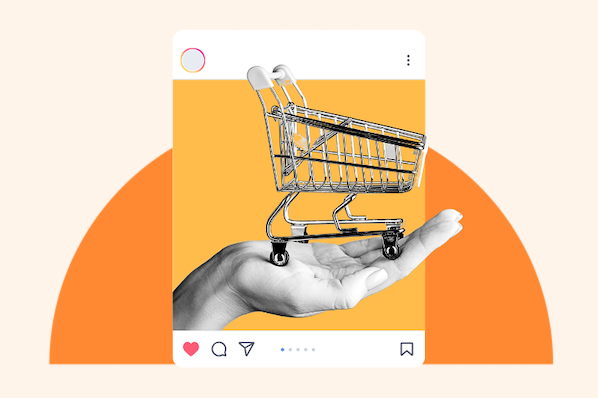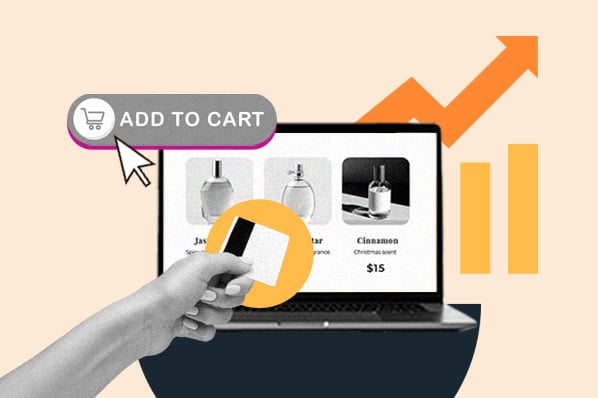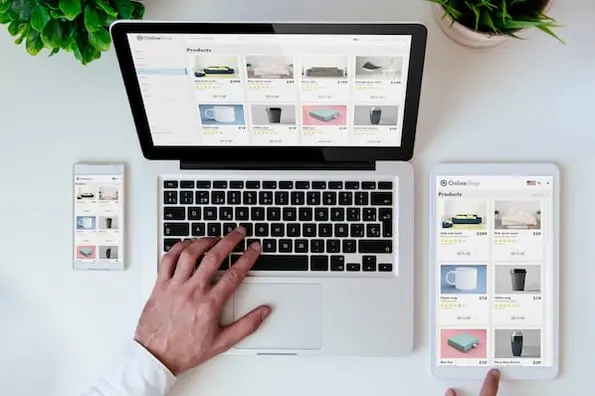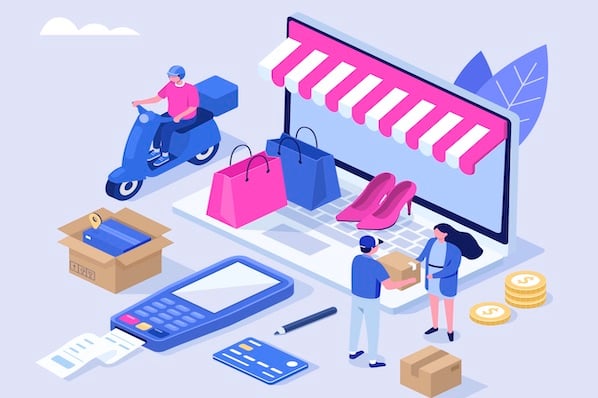1. Short-Form Video
Short-form video has taken the social media world by storm, and platforms like TikTok have become legitimate vehicles to promote your businesses
I recently took a stab at using TikTok to promote my Etsy store, and was surprisingly happy with the results. While my business account has a modest 62 followers, I was able to generate over a hundred likes on my first video.
If you decide to veer into TikTok territory, here's a word from the wise: don't be overtly promotional. TikTok users are pretty good at sniffing out a promotional video from an organic one.
Instead, adapt your content for the platform. This means jumping on trending music, effects, and video concepts, like in the example below:
2. Direct Messages (DMs) for Customer Service
Most of my customers message me directly on Etsy. However, I've noticed an increasing number are reaching out via Instagram. This mirrors a larger trend in the ecommerce world.
19% of consumers have reached out to customer service via DMs in the past 3 months, up 45% from 2022.
.webp?width=650&height=395&name=Consumer%20Trends%20Report_300-08%20(1).webp)
What does this mean for ecommerce store owners? For one, you'll need a more diverse customer service strategy, one that spans multiple platforms. Ignoring or delaying responses on channels like Instagram or Twitter could result in lost sales or declining customer satisfaction.
If you run a larger operation, consider investing in customer relationship management (CRM) software that can manage multi-channel interactions. On top of that, make sure your customer service teams are trained to handle messages professionally on social media.
3. Social Commerce
Would you ever buy a product on Instagram or TikTok? Nearly half (47%) of social media users would.
What's more, 42% trust social media platforms with their credit card information.
Social media is no longer just a tool for promotion — it's a marketplace where you can sell products directly to consumers. Take Instagram Shops, for example. You can open a storefront, add products, and run ads to boost awareness, directly from the Instagram app.
Social media is ushering in a new era for digital commerce. Those that leverage social media as a direct sales channel can access an enormous— and still growing— customer base. Platforms like Whop.com allow users allow creators and influencers to leverage their social media audience to sell anything from community access to digital products.
4. Sustainable Shopping
Now, more than ever, consumers want to back companies that align with their core values. Case in point: 46% of consumers are more likely to purchase from a company that actively donates to charity.
In my ecommerce store, all materials are ethically sourced, which is a point I mention in each of my product listings. This is a great way to let potential customers know about the ethical considerations that are central to my business.
Corporate responsibility isn't just lip service; it's actually influencing consumers' purchasing decisions — and I predict more ecommerce stores will start prioritizing sustainable sourcing, packaging, and manufacturing in 2024.
5. Same-Day or Next-Day Delivery
Amazon has opened nearly 45 shipping sites in the last four years, and is expected to grow this to 150 in the next several years.
When you consider 40% of U.S. consumers expect their online delivery to take two to three days to arrive, this play makes sense.
But the need for (delivery) speed isn't just for big retail giants.
Just last week, I received a notification from Etsy that sellers could update their processing time to include weekends. Meaning, if you fulfill orders on Sundays, your customers will see faster delivery times. I've personally discovered that the quicker my processing times on Etsy, the more customers want to buy.
Consumers don't just want fast delivery times, they expect it. In some cases, they even fork over more money for same-day or next-day delivery. If you don’t give consumers these options, they may turn to competitors who do.
.webp?width=650&height=276&name=ecommerce%20trends%20(1).webp)
6. Augmented Reality and Virtual Reality
When I moved into my apartment last year, I was on the hunt for the perfect couch. Nothing too bulky, or ornate, or mismatched with my existing decor.
The problem? As I was perusing Ikea's website, it was hard to envision what each couch would look like in my space from the product photos alone.
Fortunately, Ikea offers an AR app that lets you place 3D products in your home. The products are true-to-scale, so you can see whether it will fit and how it’ll look in your room.
Augmented reality and virtual reality will continue to keep the pace in 2024. Eventually, it will become standard for companies to offer AR and VR options.
Ultimately, these added benefits are worth the initial investment in new technology. As ecommerce grows, consumers are going to buy from companies that allow them the option of visually testing out products before purchase.
7. Livestream Shopping
Ever wanted to sell your wares on QCV or HSN? Now you can do something similar on social media.
In 2019, Amazon launched its livestream shopping platform, Amazon Live. Two years later, TikTok began testing a live shopping function in the United States. YouTube and Shopify closely followed suit, expanding their live shopping partnership.
All of these investments signal a more immersive and interactive future for e-commerce, one that goes beyond scrolling through static images and reading product descriptions.
8. Automation and Chatbots for Online Ordering
With 1.3 billion people on Facebook Messenger, it makes sense to take advantage of chatbots for marketing, customer service, and sales.
With ecommerce, you can take it a step further.
Domino’s uses its Messenger bot, Dom, for full-menu ordering. The implications of this are huge: when fast and simple are priorities for consumers, Domino’s will beat out all the competition.
Plus, chatbot ordering is an opportunity for Domino’s to cater to its audience in a new way, proving itself to be a helpful and forward-thinking company.
If it makes sense for your business, I’d suggest creating a chatbot like Dom while it’s still an open field. In a few years, this could become a mainstream way of ordering, and lose some of its current novelty power.
9. Mobile First, Desktop Second
When shopping online, roughly 75% of consumers prefer using their mobile devices, compared to 15% that prefer desktop and 6% that prefer tablet.

As mobile purchasing continues to grow, it’s important to create an ecommerce site that’s optimized for mobile.
Fingerprint and facial recognition technology, as well as one-click payments, will simplify mobile payments and further encourage consumers to switch from desktop to mobile. Mobile will soon become the preferred payment method for ecommerce transactions.
Starbucks created a Mobile Order and Pay app in 2015. By 2021, 26% of all Starbucks orders were paid via mobile. Starbucks said their Mobile Order and Pay app is so popular, it creates congestion in stores and extra-long wait lines, which they’re attempting to solve by hiring more baristas.
If mobile ordering leads to a larger pool of in-store consumers, I’m thinking it’s a worthwhile investment.
10. Image Search
Picture this: you’re in a store and see a beautiful couch but don’t feel like paying full price, so you take a picture of it and use eBay’s image search to find similar products for a better deal.
As ecommerce transitions to mobile, companies will begin offering options to visually search for products by using personal photos, or photos found online.
Since image search offers opportunities to find similar products at a cheaper price online, it could eventually drive consumers to shop online even if they started in a physical store.
A few ecommerce businesses have already successfully implemented image search functions into their online platforms. Pinterest, for example, has its own image search function. On Pinterest, you can zoom in on an object in a Pin image and find similar objects.

11. Voice Search
As Amazon Echo, Google Home, and other voice-activated devices grow in popularity, voice search will become the preferred method of search. Around 40% of U.S. internet users use a voice assistant at least monthly.
It’s critical to optimize your business for voice search in 2024, or you could lose the vast majority of consumers who choose to shop through voice-activated devices.
Walmart made it possible for consumers to order any of their items by voice on the Google Express, and in the future, they’re going to allow consumers to place in-store pickup orders via Google Home. Target, Costco, Kohl’s, Staples, Walgreens and many other stores are in the process of creating similar options for consumers.
Since voice search is 3x more likely to be local, it’s also important to ensure your business listing is updated on Google to reach those local searchers (with accurate hours, an up-to-date address, photos and reviews, etc.).
12. Product Videos
Even when consumers are online, they’re still going to have the same questions about a product’s functionality and design that they’d have in-store. To compete in ecommerce, you’re going to have to answer all their questions digitally, and one of the easiest ways to do that is through video.

A high-quality video addressing your product’s design and function is one of the best ways to sell your product. Your video can appeal to your consumer’s emotions, persuading them more convincingly than text.
Redsbaby, an Australian baby stroller company, does a great job of this. Their videos of baby strollers display actors using Redsbaby strollers throughout a “typical day,” so consumers can feel confident that they understand what they’re purchasing, despite having never seen it in-store.
13. ROPO (“Research Online, Purchase Offline”)
It can be tricky to track how your digital efforts translate to offline sales.
Luckily, ROPO (“research online, purchase offline”) is a tool that will become more advanced and reliable in the upcoming year, and can help retailers accurately measure how well their digital ads are contributing to in-store sales.
ROPO combines information from social media, mobile tracking/geolocation, mobile payments, in-store inventory, analytics tools, CRM systems, and more, to figure out which ads and site pages led consumers to in-store purchases.
This is invaluable information. By knowing which digital ads are most efficiently contributing to sales, ecommerce businesses can create higher-conversion, more targeted campaigns, and feel confident that what they’re doing online is meaningful to their consumers.
14. Machine Learning and AI
You come across machine learning and AI every day. You just might not realize it.
Take Netflix: rather than dividing viewers by age, location, or gender, Netflix created 1,300 “taste communities.” Netflix makes recommendations on similar movie or TV show preferences based on what's most popular for the viewers in that community. This is the future of machine learning.
Other ecommerce platforms will soon see personal benefits from using machine learning and algorithms to uncover which content they should deliver to which audience. In the future, content will be divided by machine learning and AI, so consumers are fed only the content (or products), they’re most interested in.
Back to You
Nowadays, stores can’t compete without offering excellent ecommerce options. It isn’t enough to post product images to your site and hope your ideal customers will find them. By embracing some of these trends, you can meet your customers where they are and offer them a positive shopping experience.
Ecommerce Marketing






![How to Write an Ecommerce Business Plan [Examples & Template]](https://53.fs1.hubspotusercontent-na1.net/hubfs/53/ecommerce%20business%20plan.png)



.jpg)
![How to Start an Ecommerce Business [Steps + Must-Follow Tips]](https://53.fs1.hubspotusercontent-na1.net/hubfs/53/how%20to%20start%20an%20ecommerce%20business.jpg)



